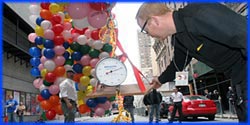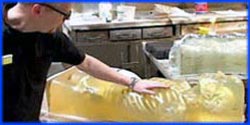


Premier Date: September 28, 2011
busted
Adam and Jamie chose one car and one motorcycle apiece from the 1980s, 1990s, and 2000s. Adam drove each vehicle for 30 minutes in the city and on the freeway, using sensors to measure the tailpipe emissions. In every case, the motorcycles gave higher fuel efficiency and lower carbon dioxide emissions than the corresponding cars. However, the cars performed better in terms of emissions of hydrocarbons, nitrogen oxides, and carbon monoxide.
At this point, Adam and Jamie decided to try and improve a motorcycle’s aerodynamic performance so that it would use less fuel and give lower emissions. They built a teardrop-shaped shell to cover the entire vehicle, with a tubular steel frame and heat-shrink plastic sheeting. Jamie then drove simulated city and highway courses at Naval Air Station Alameda on a modern motorcycle, with the shell both on and off. The shell gave the best fuel efficiency and lowest CO2 emissions, but did not perform better than the cars on the other three pollutants. They classified the myth as busted, and Jamie attributed this result to the fact that anti-pollution technology has advanced faster for cars than for motorcycles.
busted
The Build Team visited the New Mexico Institute of Mining and Technology to learn about the details of RPG use and have a place to do their testing safely and legally. Detonation of a live round showed a jet of molten metal burning through the target, which raised serious questions about a person in front being able to survive.
With help from Institute personnel, they built a rig to launch an RPG directly toward a remote-controlled gun of the same caliber as that used in the film (a Smith & Wesson Model 460 revolver). After a failed first test, they were able to hit the RPG with a bullet and see the former explode in midair. Separate shots of the two weapons on an 80-foot test range, the same distance as the film scene, led them to calculate that the bullet and RPG would collide 16 feet in front of the RPG shooter. However, the particular rounds used for these tests had fuze systems that would not arm until they had flown roughly 60 feet.
The team set up two dummies 80 feet apart, outfitted with pork-belly abdomens and foil burst gauges to evaluate injuries. Assuming that the film RPG might have had a defective fuze, the team set up a target 16 feet in front of the RPG dummy, backed the launcher up to ensure a detonation, and fired. Both dummies survived without injury, though molten metal flew through the air just to each side of the handgun dummy. The need for a bad fuze, the forward direction of the explosion, and the fact that the intended target survived only through sheer luck led the team to call the myth busted.
Previous: Episode 170: Paper Armor